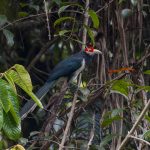
Rotterdam is the only city in the world where shops sell shirts with the sleeves already rolled up. It’s a city that prides itself on its hard work mentality, diversity, modern architecture, its absolutely fantastic football club Feyenoord, and its super-sized port. It’s this port we will be visiting.
The Rotterdam port stretches from its origin near the St Laurens cathedral to the second Maasvlakte – a distance of 40 km as the Carrion Crow flies. Buried beneath the port: entire villages and pretty awesome natural areas. All that’s gone but in return we now have “rocky shores”, endless steppe-like areas and the province’s tallest mountain, a toxic waste dump. Note – Dutch people will call “mountain” anything above the height of a dike and I see no reason to change that convention just because some of you live in the Alps, Rockies, Andes, or Himalayas.

The city centre consists of shopping areas and lots of harbours. These harbours have their population of Mute Swan, Mallard and Black-headed, Herring, Lesser Black-backed and Mew Gull. The trees lining the harbours can contain anything from House Sparrow (yes, they are still here!), European Blackbird, Chaffinch, Great Tit, Rose-ringed Parakeet and other common birds. The birds are very approachable. You won’t be adding “ticks” to your list of lifers but you would be able to see a pair of Great Crested Grebe care for their young up close and personal. While enjoying a cold beer or a hot coffee.

Jackdaws and Carrion Crows eat discarded chips throughout the city. My award-winning picture of a Feral Pigeon was of course taken in Rotterdam. Even somewhat exotic birds like Red-crested Pochard are always a possibility.

If you have to rely on public transport there’s quite a few options. The metro can take you to the Kralingse Bos – a large and relatively wild park and lake. The combination of woods and water will almost guarantee a full slate of common Dutch birds, with an occasional less common specimen thrown in for good measure. Alternatively, take the Water Bus out of the city to Krimpen aan den IJssel. A short walk from the ferry’s quay – through a very unappealing industrial area – is the Stormpoldervloedbos, a tidal freshwater swamp. Amazingly, it’s not an eBird hotspot. When I lived in this village (obviously prior to my eBirding days) I visited often, because this is a very reliable place to see Marsh Warbler. The tides also create rare botanical circumstances. Do watch those tides – you do not want to be trapped here due to the rising tide. If you rent a bike in Rotterdam you can explore further afield or continue sailing to Kinderdijk for the windmills.

If you were to have a car you can follow the Village People and go west. To the new ports – built in the second half of the last century. Big enough quays and deep enough water to receive super-tankers and enormous container ships. The newer parts of the port are vast and relatively empty. Many species come here to winter, breed or moult despite the presence of six refineries. For instance, Lesser Black-backed Gulls have a substantial breeding colony right next to a chemical plant. Heading west on the A15 you will soon realise how far west you actually are: you will pass a sign telling you to turn right for England! Instead you will continue straight ahead on the A15 for many kilometres until exit 8, Oostvoorne-Brielle-Rockanje. Turn off, follow the parallel road towards the Slufter, the mountain… There’s a hide overlooking the Oostvoornse Meer and the recently created Slikken van Voorne. When I visited in February a cold strong wind prevented me from staying too long, but I managed to see sizable flocks of Greylag Goose, Eurasian Oystercatcher, Eurasian Curlew, Sanderling, Dunlin and Herring Gull from the look-out point. A nearby little wetland allowed me some good looks of Greylag Goose, Canada Goose; Egyptian Goose, Mallard and Eurasian Teal. This place becomes very “ducky” when temperatures start rising.

If you continue straight instead of turning towards the Slufter you will be entering the Maasvlakte – a wide open steppe-like area. Most of the time it will be empty bar the occasional Common Kestrel or gull, but keep an eye on the rarity alerts and eBird. Eurasian Dotterel may even be considered a “regular” rarity. Lanceolated Warbler, Red-breasted Flycatcher, Pink-footed Goose have all been spotted in this area. Looking out to sea from one of the vantage points may occasionally result in sightings of Sabine’s Gull or Sooty Shearwater. In short: anything can show up when you show up.













Some 40 years ago, on a freezing cold day in February, I saw my first white-billed diver close to Rotterdam. (White-billed divers have since become yellow-billed loons, but they look the same). It was a twitch, as a Dutch birder had alerted us to its presence, but there was no one else looking for it, so we did have to find it ourselves. An impressive bird, and one I have only seen since in the arctic.
Exactly, David, anything can show up. Thanks for your addition to the list of possibilities.
Very interesting, David! I also happened to see my lifer White-billed Diver near Rotterdam – at Scheveningen, to be exact. This was on 31 December 1984 – could it possibly have been the same bird you saw?
Incidentally, the day before I had added my first Great Northern Diver (aka Common Loon) to my European life list at Yerseke (I had seen that species previously in the US). A very loony winter trip it was! 🙂